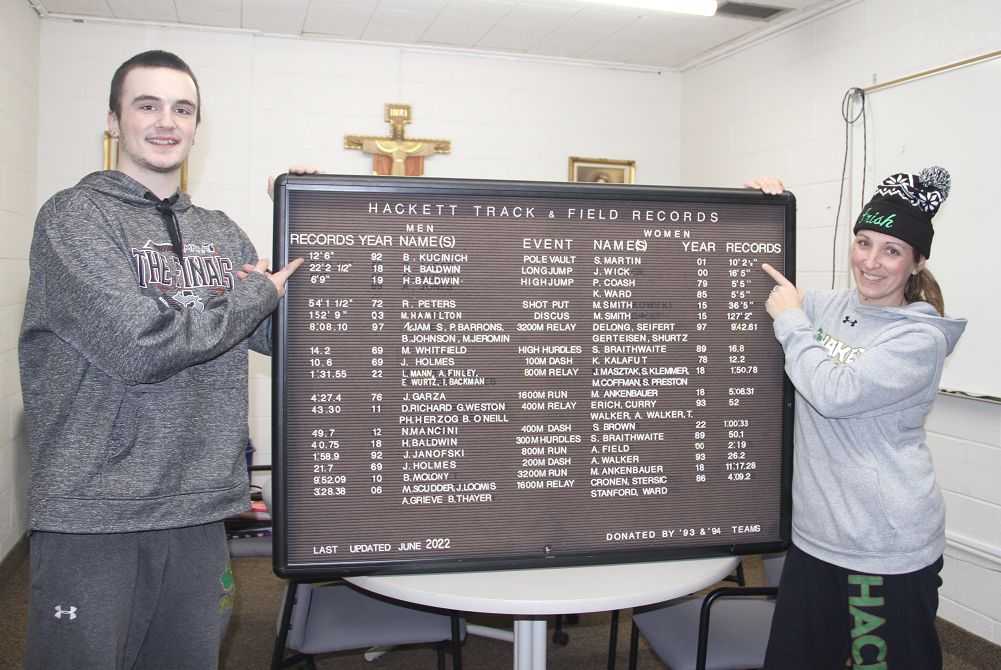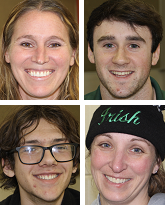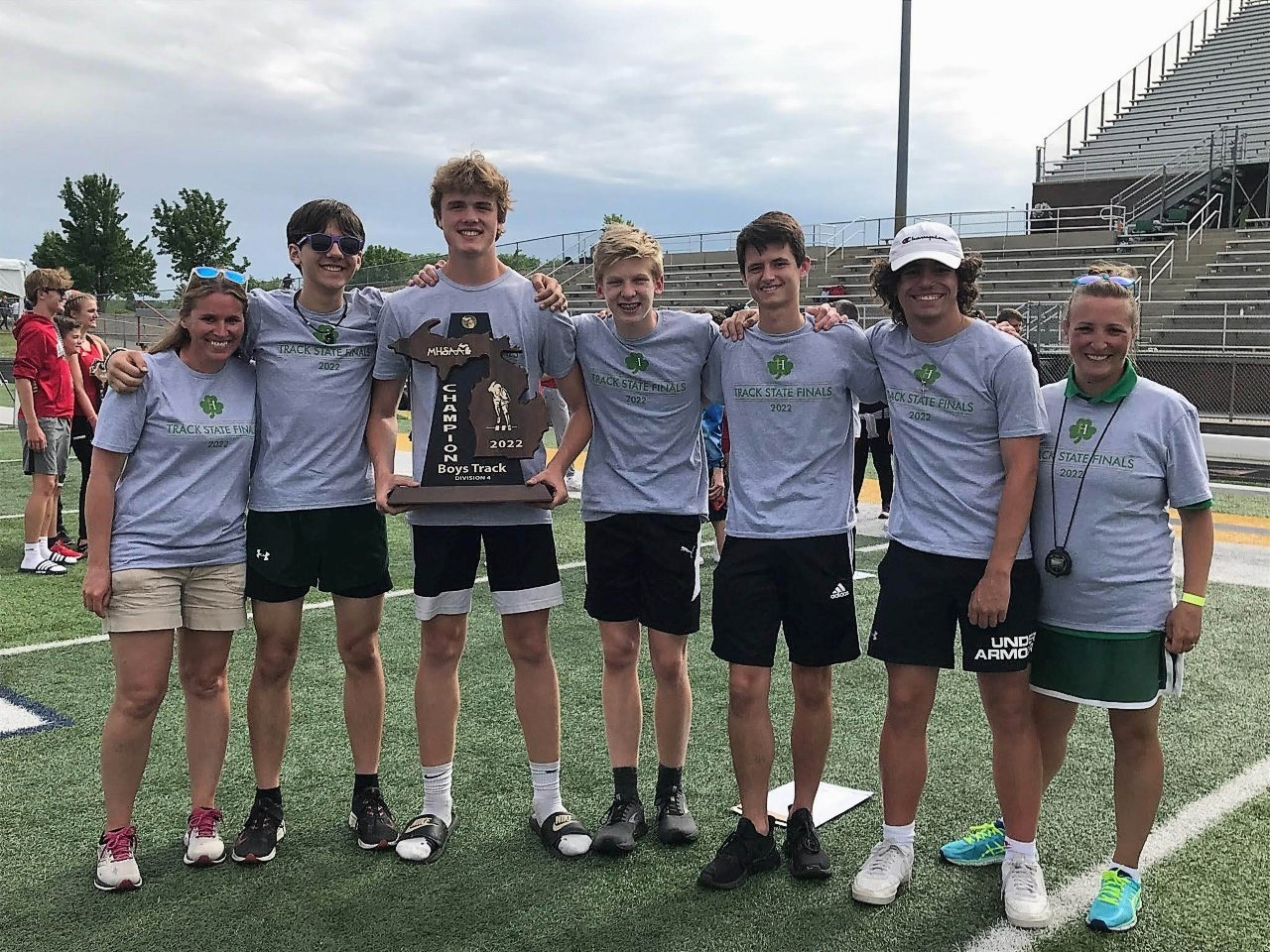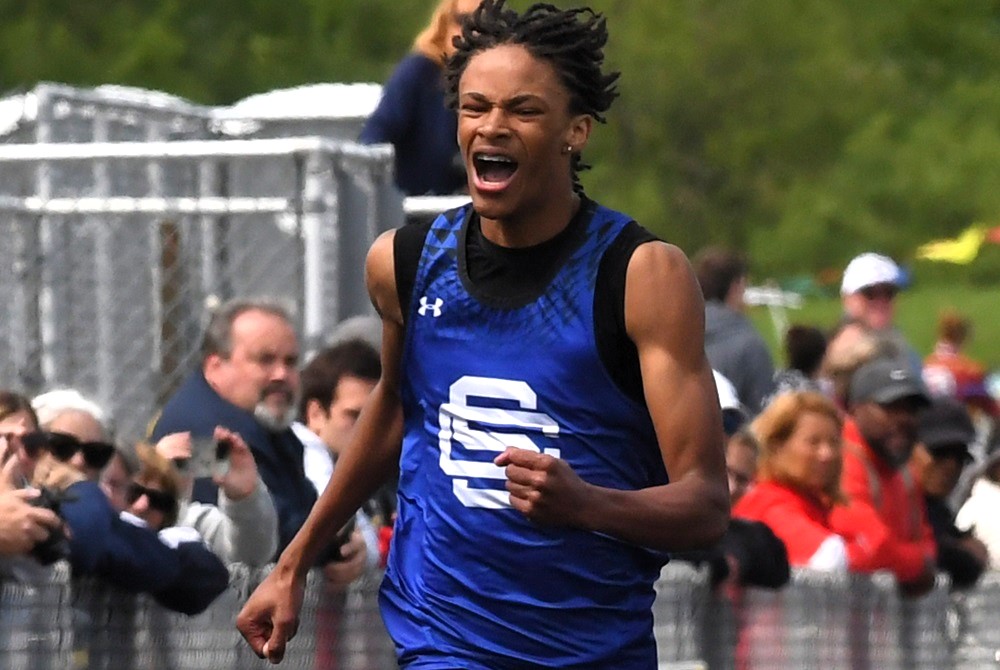
Aspirations High as Reigning Champion Hackett Vaults Into New Season
By
Pam Shebest
Special for MHSAA.com
March 14, 2023
KALAMAZOO — Harrison Wheeler has not been a pole vaulter for very long – two weeks to be exact – but he already has some lofty goals.
 The sophomore is aiming for the Kalamazoo Hackett Catholic Prep record board and, if he makes it, he will be in good company.
The sophomore is aiming for the Kalamazoo Hackett Catholic Prep record board and, if he makes it, he will be in good company.
Coach Shelly (Martin) Germinder, a 2001 Hackett graduate, still holds the girls record of 10 feet, 2½ inches.
“I’m hoping to have my name next to hers (on the record board),” Wheeler said.
The sophomore has a few feet to go before surpassing current record holder Brian Kucinich, who vaulted 12 feet, 6 inches in 1992.
Wheeler’s unofficial best is 9 feet; officially it is 8 feet, 6 inches.
“That is going to be a very big jump in my pole vaulting career,” he said.
Wheeler is one of 42 athletes on the reigning MHSAA Lower Peninsula Division 4 champion boys team, which includes 12 seniors and 13 juniors. Besides Wheeler, the team has six sophomores and 10 freshmen.
One of the returners is senior Liam Mann, who helped lead the Irish to the Finals title last year.
Mann, Andrew Finley, Evan Wurtz and Isaac Backman won the 800-meter relay with a time of 1:31.55 last season, setting a school record as well.
While he lost his relay mates, Mann said there are good runners to replace them.
“(Senior) Brice Brown is coming out to do track, and I’ve been working with him this winter,” Mann said. “Jude Coffman, who is a sophomore, is coming out this year. I think he’s going to be a good addition to our 4-by-1.
“(Junior) Gabe Oeurn, last year he was running solid times, but this year he’s been putting in the work and I think he’ll be able to break that 12-second barrier.”
Mann, who will attend Ashland (Ohio) University on a track scholarship in the fall, also added gold in the 200-meter dash (22.82) last season.
“Last year, I played basketball and was able to lift to keep in shape,” he said. “This year, I wanted to focus all my time on track, so I’ve been doing indoor track, practicing once a week and going to meets on weekends.”
He continued to put his skills on display as a running back during football season with Kalamazoo United, ending the fall with 1,413 rushing yards on 177 carries and 267 receiving yards on 10 catches.
Opportunities & possibilities
The biggest group of competitors impacted by graduation are the sprinters, coach Charissa Dean said.
“Hackett’s been really big on sprinting talent in general,” she said. “But track has 17 events, and only two of them are open sprint events and two are relays.
 “The other 13 are wide open for possibilities, and there’s a lot of younger talent that’s coming back this year. While they didn’t go to the state meet, they are the next generation of athletes coming up.”
“The other 13 are wide open for possibilities, and there’s a lot of younger talent that’s coming back this year. While they didn’t go to the state meet, they are the next generation of athletes coming up.”
Among that next generation are freshmen Marek Butkiewicz and Sean Siems, who “are incredibly talented athletes,” Dean said.
“(Junior) Gavin Sehy figured out how to do the distance thing this year in cross country.”
Sehy said he wanted to run track, but wasn’t sure where he fit.
“I thought I was mid-distance when I was younger, but my dad forced me to do cross country my sixth-grade year and it turned out I was decent at it so I kept doing (long distance) in track,” he said.
“It’s kind of brutal at times to train for long distance, mentally and physically, because you have to go on long runs, but I have fun with it. At the cross country state finals, I hit an 11 flat split at the two-mile, which beat my 3,200 best from last season, so we have yet to see my best times.”
Butkiewicz and Sehy have been running consistently six days a week all winter to prepare for their first meet, March 22.
“I’ve never done track,” the freshman said. “I know I can perform well. I know my times compared to other people.”
A sophomore this year, Alex Dumont had a 400-meter time that “came out of nowhere,” Dean said. “Toward the end of the season we recruited him to do the 4x8, so an 800-meter runner. That kid came through.
‘We actually took him to the state meet in the 4x8. He did the lead leg, and I clocked him at a 2:07. He was sprinting. It was an amazing leg in that relay.”
Seeing potential
It was Germinder who converted Wheeler to the pole vault last year.
“Harrison’s a strong athlete, and just the way his mind works in that he asks questions and he wants to learn and he wants to improve,” she said.
“He wants to work hard, and he wants to put in the time. That’s something you need for that, along with the athletic component.”
 Wheeler, who said he was shocked at being successful right away, competed for two weeks last season before a foot injury suffered on a vault sidelined him.
Wheeler, who said he was shocked at being successful right away, competed for two weeks last season before a foot injury suffered on a vault sidelined him.
“It took her a whole season to finally convince me to do it,” he said. “I grabbed a pole one day and ended up being really good at it. Ever since, I’ve had a love of it.
“The feeling I have once I get in the air is almost like I’m just floating. When you get really good vaults and you get that nice height and good form, you get what we call a ‘stall.’ You just feel like you’re sitting up in the air for a second. It’s gotta be the coolest thing ever.”
Germinder has the background to help the Irish vaulters.
While at Hackett, she competed in the AAU National Championships and said she learned from the best, Oran Mitchell, a noted pole vaulting coach.
Her own coaching style revolves around the safety of the athletes.
“You can teach a lot of people to grab hold of a pole and pop yourself over,” she said. “But I want to make sure my athletes are safe. That’s really, really important to me, and that’s something that was instilled in me.
“When you’re jumping 6 to 16 feet, that’s a long way to fall. Safety is very important to me. If you’re not willing to put in the time, then I’m not the coach for you.”
Germinder said one of the foundations on which the team is built is leadership, which was instilled in the younger athletes by last year’s seniors.
“That’s one of the things our program is built on,” she said. “If you’re there because you want to get ready for the next sports season, we’ll coach you for that.
“If you want to be a state champion, we’ll coach you for that. That’s the really unique thing about track. There’s something for everyone, whatever that might be.”
As for the girls team, numbers are steadily climbing.
Five years ago, the team had just two girls. This year, 25 girls are on the team.
No matter girls or boys, track or field events, one thing is common for all the athletes.
“We pray before every meet, we put God first, and all those pieces have fallen into place for us.” Germinder said.
“I really believe that foundation is what is going to be our success this year. It’s there, it’s just a different team.”
 Pam Shebest served as a sportswriter at the Kalamazoo Gazette from 1985-2009 after 11 years part-time with the Gazette while teaching French and English at White Pigeon High School. She can be reached at [email protected] with story ideas for Calhoun, Kalamazoo and Van Buren counties.
Pam Shebest served as a sportswriter at the Kalamazoo Gazette from 1985-2009 after 11 years part-time with the Gazette while teaching French and English at White Pigeon High School. She can be reached at [email protected] with story ideas for Calhoun, Kalamazoo and Van Buren counties.
PHOTOS (Top) Hackett's Harrison Wheeler points to the pole vaulting record he hopes to break this season, while pole vaulting coach Shelly (Martin) Germinder points to the record she still holds at the school. (Middle) Clockwise from top left: Hackett head track & field coach Charissa Dean, Liam Mann, Germinder and Gavin Sehy. (Below) The Irish celebrate last season’s Finals championship, from left: Dean, Sehy, Logan St. Martin, Alex Dumont, Mitch Eastman, Nick Doerr and Germinder. (Top photo and head shots by Pam Shebest; team photo courtesy of Hackett track & field.)

Performance of the Week: Southfield Christian's Brock Morris
June 5, 2025
 Brock Morris ♦ Southfield Christian
Brock Morris ♦ Southfield Christian
Senior ♦ Track & Field
Morris finished an individually-phenomenal day at Saturday's Lower Peninsula Division 4 Finals by helping his teammates make school history. With Southfield Christian trailing leader Kalamazoo Hackett Catholic Prep by three points heading into the final event of the day, Morris anchored the Eagles' 1,600 relay and crossed the finish line first – which, combined with Hackett's third-place finish in the race, gave Morris and his teammates their school's first Finals team championship in track & field by one point.
That victory capped a day that also saw Morris win the 200 and 400-meter open races and run on the winning 800 relay as well. Morris was part of school records in all four of those races this season and the 400 relay as well; the 1,600 relay time of 3:24.36 on Saturday lowered that school record and also included Dylan Taylor-Wilkerson, Robert Brown and Jadon Staten. Morris also ran cross country and played point guard on the boys basketball team. He will study at University of Michigan, majoring in biology, health and society on a pre-medical track.
@mhsaasports 🏃♂️POW: Brock Morris #southfieldchristian #track #finals #winner #1600relay #anchor #part1 #highschoolsports #tiktalk #interview #performanceoftheweek #mistudentaid #fyp #MHSAA ♬ original sound - MHSAA
@mhsaasports 🏃♂️POW: Brock Morris #instagram #chocolatemilk #hidden #talent #emoji #part2 #performanceoftheweek #mistudentaid #fyp #MHSAA ♬ Monkeys Spinning Monkeys - Kevin MacLeod & Kevin The Monkey
Follow the MHSAA on TikTok.
MHSAA.com's "Performance of the Week" features are powered by MI Student Aid, a division within the Department of Lifelong Education, Advancement, and Potential (MiLEAP). MI Student Aid encourages students to pursue postsecondary education by providing access to student financial resources and information. MI Student Aid administers the state’s 529 college savings programs (MET/MESP), as well as scholarship and grant programs that help make college Accessible, Affordable and Attainable for you. Connect with MI Student Aid at www.michigan.gov/mistudentaid and find more information on Facebook and Twitter @mistudentaid.
Previous 2024-25 honorees
May 30: Chloe Qin, Bloomfield Hills Cranbrook Kingswood tennis - Report
May 23: Drew Goik, Bay City Western golf - Report
May 15: Sydney Kuhn, Saginaw Swan Valley track & field - Report
May 8: Ryan Bosch, Fruitport baseball - Report
May 1: Jackson Lam, Kalamazoo Loy Norrix track & field - Report
April 25: Isabelle Horvath, Bangor softball - Report
April 18: Presley Jones, Sterling Heights Stevenson soccer - Report
April 11: Olivia Jasniewicz, Troy soccer - Report
March 27: Katie Spicer, Fowler basketball - Report
March 21: Moses & Markus Blackwell; Warren Lincoln basketball - Report
March 13: Keyshawn Summerville, Lansing Sexton basketball - Report
March 6: Maggie Buurma, Fowlerville wrestling - Report
Feb. 28: Maren Studt, Pontiac Notre Dame Prep skiing - Report
Feb. 21: Olive Krueger, Marquette swimming - Report
Feb. 14: Hunter Lemmon, Fraser swimming - Report
Feb. 7: Aubrey Hillard, Rochester competitive cheer - Report
Jan. 31: Wyatt Spalo, Reed City wrestling - Report
Jan. 24: Olivia Flynn, Harbor Springs basketball - Report
Jan. 17: Levi Rozema, Holland Christian swimming - Report
Jan. 10: McRecco McFadden, Burton Bentley basketball - Report
Dec. 18: Nash Leonard, Bay City Western hockey - Report
Dec. 11: Blake Cosby, Dundee wrestling - Report
Dec. 4: Keaton Hendricks, Zeeland West football - Report
Nov. 29: Kate Simon, East Grand Rapids swimming - Report
Nov. 22: Ella Kokaly, Essexville Garber volleyball - Report
Nov. 15: Caroline Bryan, Grosse Pointe South swimming - Report
Nov. 8: Kaylie Livingston, Whitmore Lake cross country - Report
Oct. 25: Oliver Caldwell, Grand Rapids West Catholic tennis - Report
Oct. 18: Alex Graham, Detroit Cass Tech football - Report
Oct. 11: Victoria Garces, Midland Dow cross country - Report
Oct. 4: Asher Clark, Bay City John Glenn soccer - Report
Sept. 26: Campbell Flynn, Farmington Hills Mercy volleyball - Report
Sept. 19: TJ Hansen, Freeland cross country - Report
Sept. 12: Jordan Peters, Grayling soccer - Report
Sept. 6: Gabe Litzner, Sault Ste. Marie cross country - Report
Aug. 30: Grace Slocum, Traverse City St. Francis golf - Report
(Photo by RunMichigan.com.)

